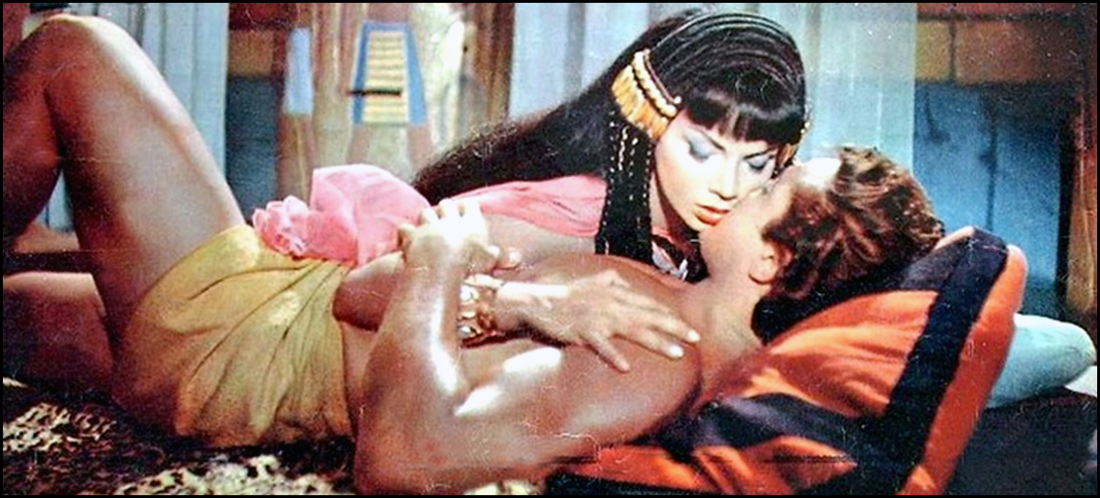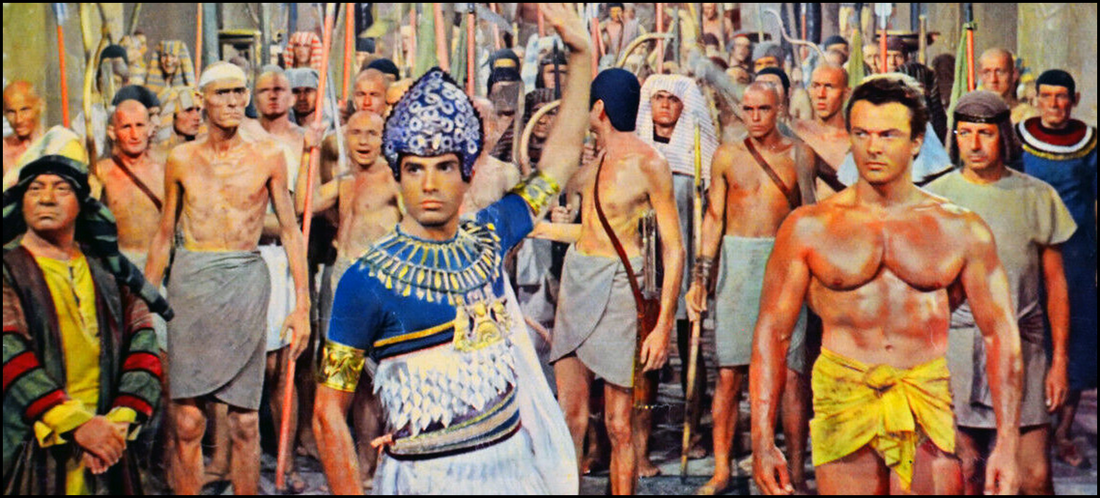As I’ve mentioned ad nauseum, I grew up in an era where most households could only rely on whatever movies were sold to the syndicated television market for young’uns to watch; and that meant my entertainment diet was heavily flavored with black-and-white SciFi/Horror films on the 1950’s, Japanese import live action series of the 1960’s, and a sprinkling of European flicks that ranged from the unusual to the obtuse. For a time, I recall one TV station played a rotation of Hercules features (along with some like-minded fare), and – though I don’t recall every picture by name – I’m quite certain I’ve seen Son Of Samson (1960) from Gallus Films.
How can I be so sure?
Well, even as a little guy, I was a ‘thinker.’ So if a little something something was titled ‘Son Of Samson,’ then I grew curious why there was no Samson by name in the cast! Who was this Samson? Why was no one calling him out by name? I was too young to understand the nuance of how some studio executive opted to rename ‘Maciste In The Valley Of The Kings’ to something he or she thought American audiences would understand (such as biblical strongman Samson), and the inference was likely lost on me. I guess I just wasn’t worldly enough.
Still, films like it always kept my attention. As a young reader of comic books and a fan of anything remotely resembling a superhero, these cinema strongmen were equally interesting, even though I rarely understood all of the plot nor much cared about the romantic entanglements. Any bulked-up dude who could hurl boulders into a line of approaching soldiers? Well, that deserved my attention, so I took it all in at every opportunity.
As one who continues to study film later into my years, I’m fortunate enough to rediscover my love of some of these older features today as outfits like Kino Lorber are restoring them with home video releases. Son Of Samson might not be one of my favorites, but there’s still a resonance that shines through. It was a particular picture representative of a particular era of storytelling, and I think audiences might appreciate a kindler, gentler version of Fantasy epic in lieu of the usual spandex-and-tights crowding the cinemaplex screens today.
From the product packaging:
“During the Persian rule over Egypt, the mighty Maciste travels to the city of Tanis where the evil Queen Smedes rules with an iron fist and spreads misery across the land. Possing legendary brawn and courage, Maciste leads a mass revolt against the queen and her tyrannical reign of terror.”
Now, I’m not so old that I can’t appreciate the changes to visual narratives most audiences love these days. Certainly, technology – and the advent of CGI – have blessed storytellers with an incredible chest of tools to consider when building films today. George Lucas and others have brought whole planets to life, building whole empires and rebellions out of pixels whereas trailblazers only decades before had to rely on incredible filming locations and craftsmen who could work within a budget to accomplish the same. Still, I’ve always maintained that I prefer physical production over a computerized alternative, largely because it’s still all-too-easy to detect what’s real and what isn’t when considering images up on the silver screen.
Because most who purchase tickets to today’s releases have likely never seen a production without some measure of CGI, I’d argue they simply can’t appreciate the work and talent that went into bringing Son Of Samson to life. Even though I suspect a fair amount of its buildings were likely existing framework repurposed by studio staff to turn it from the Old West to Ancient Egypt, there’s a talent to achieving a consistent aesthetic – along with an eye for detail – that can’t be match digitally … and an awful lot of that is on display in this ninety-minute creation. Sets. Props. Costumes. It’s all part-and-parcel of mythmaking, and this Samson should be celebrated no less.
Thankfully, director Carlo Campogalliani was no stranger to the challenges of these Greco-Roman flicks (there were just really starting to take off in popularity) and had already ‘cut his teeth’ with Goliath And The Barbarians (1959). (For the record, he’d also worked on some of the silent films featured Maciste decades before.) He’d go on to shoot Ursus (1961) after this; and the greater peplum movement of Italian cinema was in full swing. His star – Mark Forest (as Maciste) – would go on to make an additional six appearances as this particular screen hero, a mighty warrior whose origins are never quite explored but seems to appear whenever ‘the people’ needed him most. His name – “Maciste” – translates to “born of the rock,” suggesting even that he’s tied to this world in a way like no other drawn from mythology. Even Wikipedia.org lists the character as one of the oldest recurring characters in all of film, typing him to no particular era or genre. How’s that for timelessness?
For what it’s worth, Forest looks the type of a screen Hercules just right (he’s Arnold Schwarzenegger long before that marquee player caught the limelight), but his performance never quite hits the mark solid. His delivery is a bit stiff at times, and he occasionally seems to be more involved with ‘flexing’ his arm and chest muscles than otherwise reacting to the plight of those around him. His film career amounts to just over a decade spent in thirteen different projects (per IMDB.com), at which point he pursued a life in music as an opera singer. (If his heart wasn’t really in acting, then maybe that’s what came across on the screen.) Also, the script from Oreste Biancoli and Ennio De Concini sticks fairly close to a formula – people are oppressed, one man rises up to inspire them to revolt, etc. – doesn’t deliver any major scenes for Forest or any of the players to truly sink their teeth into, so perhaps all involved were doing the best they could with what they were provided.
As such, it’s her responsibility to seduce the hero, and might I say she performs admirably in perhaps one of screendom’s most tempting dance sequences ever? If IMDB.com has its facts correct, then the lady was revered for her seductive and exotic belly-dancing a few years before these scenes were captured; and I’ve no doubt that producers knew exactly what they wanted when they cast her in the role. She appeared opposite bodybuilder-turned-actor Steve Reeves in 1959’s Sign Of The Gladitor and, reportedly, stole that film’s thunder. In Samson, Forest does what he can to share space with her during the sequence … which essentially amounts to sitting there in disbelief while – on again – flexing those pectorals.
Sweet Mother of Dragons, that woman could move.
Son Of Samson (1960) was produced by Panda Societa per L’Industria Cinematographica and a few other participants. DVD distribution (for this particular release) is being coordinated via the reliable Kino Lorber. As for the technical specifications? Wow. Despite the occasionally wash-out of colors, I found much of this to look far better for a decades old production than I expected (having reviewed similar fare), so hats off to all involved.
As for the special features? Folks who read here often know that I’m notoriously hard on commentary tracks … but let me tell you: the one Kino Lorber provided here is a delight from start-to-finish. It’s a dialogue between Film Historian David Del Valle and Filmmaker/Historian Michael Varrati, and the two shares facts, figures, and tidbits about this film (in particular) while balancing out their narrative with the whole peplum movement. Usually, I’ve found historians focus too broadly on their knowledge, but most here do a masterful job of tying the discussion directly to some aspect of Son Of Samson … and it’s one of my favorites. Ever. Nice work, fellahs.
Highly recommended. Honestly, you folks know I’m a sucker for older pictures. True. While Son Of Samson was a bit dry in its first half, the second half was quite good. A bit too much felt a bit too formulaic, and maybe a performance or two with greater melodrama might’ve notched this one a bit higher on the pole. It’s good, but being drawn from the early days of peplum might’ve held it back. Production values are fabulous, and it’s still worth a view. But – seriously – don’t miss the commentary track. Watch it once you’ve enjoyed the feature. I guarantee that you’ll likely have as much fun with it as I did.
In the interests of fairness, I’m pleased to disclose that the fine folks at Kino Lorber provided me with a complimentary Blu-ray of Son Of Samson (1960) by request for the expressed purposes of completing this review; and their contribution to me in no way, shape, or form influenced my opinion of it.
-- EZ




 RSS Feed
RSS Feed